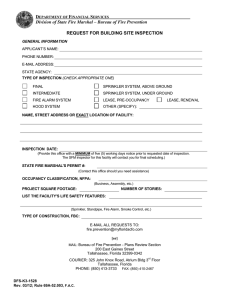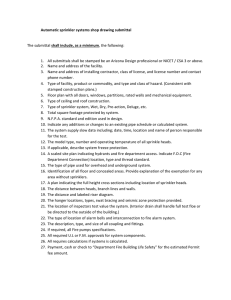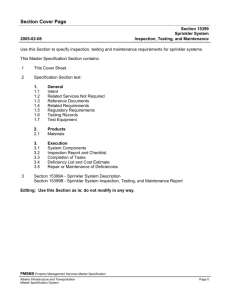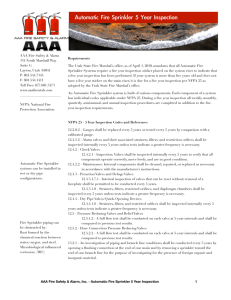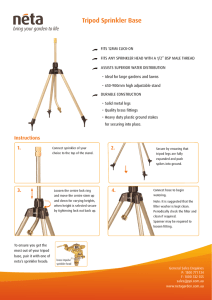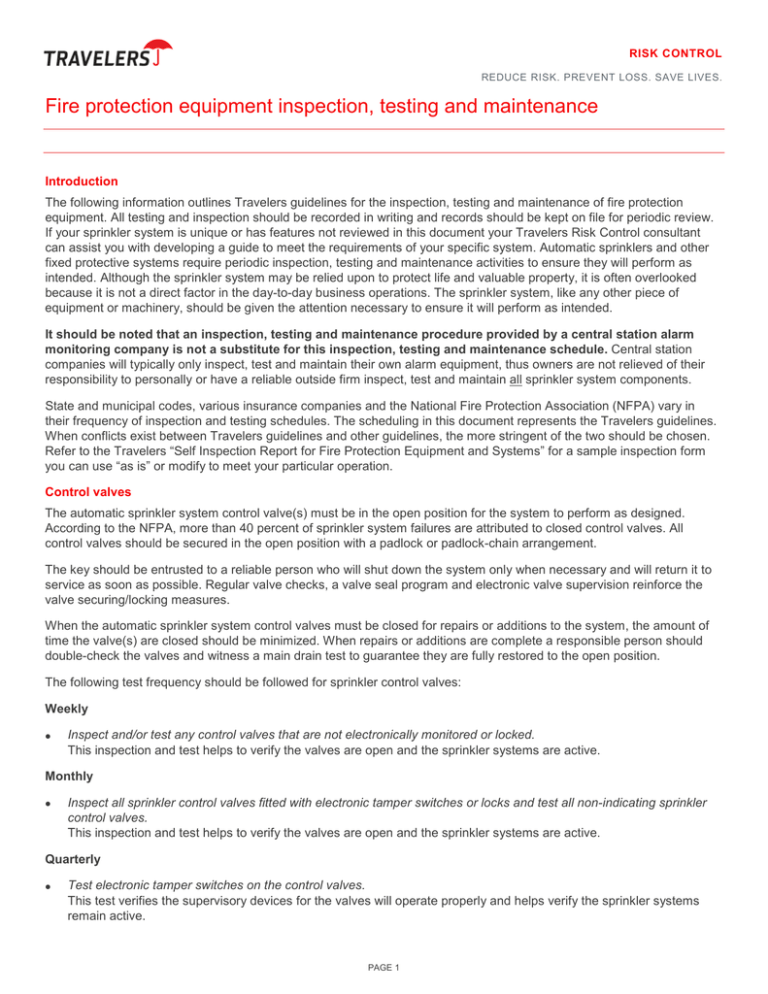
RISK CONTROL
REDUCE RISK. PREVENT LOSS. SAVE LIVES.
Fire protection equipment inspection, testing and maintenance
Introduction
The following information outlines Travelers guidelines for the inspection, testing and maintenance of fire protection
equipment. All testing and inspection should be recorded in writing and records should be kept on file for periodic review.
If your sprinkler system is unique or has features not reviewed in this document your Travelers Risk Control consultant
can assist you with developing a guide to meet the requirements of your specific system. Automatic sprinklers and other
fixed protective systems require periodic inspection, testing and maintenance activities to ensure they will perform as
intended. Although the sprinkler system may be relied upon to protect life and valuable property, it is often overlooked
because it is not a direct factor in the day-to-day business operations. The sprinkler system, like any other piece of
equipment or machinery, should be given the attention necessary to ensure it will perform as intended.
It should be noted that an inspection, testing and maintenance procedure provided by a central station alarm
monitoring company is not a substitute for this inspection, testing and maintenance schedule. Central station
companies will typically only inspect, test and maintain their own alarm equipment, thus owners are not relieved of their
responsibility to personally or have a reliable outside firm inspect, test and maintain all sprinkler system components.
State and municipal codes, various insurance companies and the National Fire Protection Association (NFPA) vary in
their frequency of inspection and testing schedules. The scheduling in this document represents the Travelers guidelines.
When conflicts exist between Travelers guidelines and other guidelines, the more stringent of the two should be chosen.
Refer to the Travelers “Self Inspection Report for Fire Protection Equipment and Systems” for a sample inspection form
you can use “as is” or modify to meet your particular operation.
Control valves
The automatic sprinkler system control valve(s) must be in the open position for the system to perform as designed.
According to the NFPA, more than 40 percent of sprinkler system failures are attributed to closed control valves. All
control valves should be secured in the open position with a padlock or padlock-chain arrangement.
The key should be entrusted to a reliable person who will shut down the system only when necessary and will return it to
service as soon as possible. Regular valve checks, a valve seal program and electronic valve supervision reinforce the
valve securing/locking measures.
When the automatic sprinkler system control valves must be closed for repairs or additions to the system, the amount of
time the valve(s) are closed should be minimized. When repairs or additions are complete a responsible person should
double-check the valves and witness a main drain test to guarantee they are fully restored to the open position.
The following test frequency should be followed for sprinkler control valves:
Weekly
•
Inspect and/or test any control valves that are not electronically monitored or locked.
This inspection and test helps to verify the valves are open and the sprinkler systems are active.
Monthly
•
Inspect all sprinkler control valves fitted with electronic tamper switches or locks and test all non-indicating sprinkler
control valves.
This inspection and test helps to verify the valves are open and the sprinkler systems are active.
Quarterly
•
Test electronic tamper switches on the control valves.
This test verifies the supervisory devices for the valves will operate properly and helps verify the sprinkler systems
remain active.
PAGE 1
RISK CONTROL
Fire protection equipment inspection, testing and maintenance
Annually
•
Operate all sprinkler control valves through the full cycle.
Each valve should be closed fully and then reopened. This test helps to verify the valves can be closed if needed. The
valves should be lubricated at this time.
Sprinkler systems
A sprinkler system should be inspected, tested and maintained on a regular schedule to ensure readiness when needed.
Regular testing can expose any problems in the system so they can be corrected. Testing on a sprinkler system should
determine the operational status of the mechanical devices, such as the alarms or the dry-pipe valves. The test should
also verify the reliability of the water supply and alarm systems.
Weekly
•
Inspect sprinkler riser pressure gauges and record the readings.
This reading verifies your system is supplied with water at the indicated pressure. If the system is a dry-pipe type,
water pressure as well as air pressure readings should be taken and recorded.
Quarterly
•
Inspect fire department connections.
This inspection will verify the connections are not obstructed and nothing has been jammed into the openings.
Replace missing caps.
Annually
•
Trip test dry pipe valves.
Each dry pipe valve should be trip tested at least once each year and immediately if the system is altered. This test
should verify the systems will be able to operate automatically if needed. All low point drains will need to be drained
immediately and two weeks after the trip test.
•
Drain low point drains on dry pipe systems.
This maintenance is intended to remove any water buildup in the sprinkler lines and should be performed before the
likelihood of any freezing temperatures.
•
Inspect hose and hose stations.
This inspection will verify that the hose is in place, accessible and in good condition.
Water supply and sprinkler supervisory systems
Weekly/monthly
•
Run test of booster/fire pump.
This test is for both diesel and electric booster/fire pumps. It can be accomplished by opening the small test valve on
the pressure sensing line that goes to the fire pump controller.
Opening this small test connection simulates a pressure drop in the system which causes the pump to operate. Once
the pump is running it should operate at rated speed with recordings made of suction and discharge pressures.
For diesel engines or any other type of internal combustion engine-driven pumps, the engine should be run weekly at
a rated speed for at least 30 minutes. Electric motor driven pumps should be run monthly for at least 10 minutes. The
pump should be monitored by a responsible employee for the duration of the test to verify there is not excessive
vibration, unusual noise or excessive heat, and to detect any problems that might surface. Flowing water is not
required in this test. Refer to Travelers “Fire Pump Testing – Periodic Operational Test” document and checklists for
further information.
PAGE 2
RISK CONTROL
Fire protection equipment inspection, testing and maintenance
•
Inspect booster/fire pump.
The pump controller should remain in the automatic starting position and the pump area should be accessible at all
times. The available power supply for electric pumps and the fuel supply for diesel pumps (should be at least ¾-full at
all times) should be inspected. The pump house should be kept clean, dry and warm. Diesel engines should be
maintained at a minimum temperature of 70º Fahrenheit.
Monthly
•
Inspect the exterior of gravity tanks, pressure tanks and/or suction tanks.
This inspection will verify that the tank is in good condition and supplied with a sufficient amount of water (must be
heated during freezing temperatures).
•
Inspect hydrants.
This inspection will verify the hydrants have not been damaged and appear operational.
Quarterly
•
Test waterflow alarms on sprinkler systems.
This test is to ensure the sounding of alarms in the event of waterflow through the sprinkler system. It should be
accomplished by opening the inspector’s test connection on wet pipe systems and the alarm bypass on dry pipe
systems, which simulates the flow of one sprinkler head.
•
Test water supply at the two-inch main drain.
This test is intended to show whether or not the normal water pressure is available on the system and to indicate the
possible presence of closed valves or other obstructions in the supply pipe.
•
Test low air pressure devices on dry pipe sprinkler systems.
This test is for dry pipe sprinkler systems only. This is accomplished by turning the lever type bleeder valve located
ahead of the pressure switch one quarter turn. Closing this valve (moving the valve handle perpendicular to the 1/2"
pipeline) shuts off the water or air from the supply and opens a small orifice (pin-hole) to exhaust the pressure
between the valve and the pressure device. This should provide a low pressure actuation of the pressure device,
testing its operation. If this valve is not provided, it should be.
Annually
•
Flow test booster/fire pumps.
This test should be conducted to ensure that neither the pump nor the suction pipe is obstructed and that the pump is
operating properly per the manufacturer’s ratings. It is accomplished by flowing water through the pump and out of the
test header valves. Refer to Travelers “Fire Pump Testing – Annual Flow Test” document and checklist for further
information.
•
Test hydrants.
Flow each hydrant to remove debris and verify the hydrant is operating properly. Also, verify that the hydrants drain
properly after the flow test.
•
Shut and reopen all post indicator valves and curb box valves in the water supply to the facility’s automatic
suppression systems and lubricate as required.
Conclusion
The most effective fire extinguishing system is a well-installed, tested and maintained fire extinguishing system. Make
sure the system you have is not impaired by poor maintenance and infrequent or nonexistent inspection and testing.
For more information, log in to the Risk Control Customer Portal at travelers.com/riskcontrol. (Need help? Read
our Registration Quick Guide.) You also can contact your Risk Control consultant or email Ask-RiskControl@travelers.com.
PAGE 3
RISK CONTROL
Fire protection equipment inspection, testing and maintenance
travelers.com
The Travelers Indemnity Company and its property casualty affiliates. One Tower Square, Hartford, CT 06183
The information provided in this document is intended for use as a guideline and is not intended as, nor does it constitute, legal or professional advice. Travelers does not
warrant that adherence to, or compliance with, any recommendations, best practices, checklists, or guidelines will result in a particular outcome. In no event will Travelers or
any of its subsidiaries or affiliates be liable in tort or in contract to anyone who has access to or uses this information. Travelers does not warrant that the information in this
document constitutes a complete and finite list of each and every item or procedure related to the topics or issues referenced herein. Furthermore, federal, state or local
laws, regulations, standards or codes may change from time to time and the reader should always refer to the most current requirements. This material does not amend, or
otherwise affect, the provisions or coverages of any insurance policy or bond issued by Travelers, nor is it a representation that coverage does or does not exist for any
particular claim or loss under any such policy or bond. Coverage depends on the facts and circumstances involved in the claim or loss, all applicable policy or bond
provisions, and any applicable law.
© 2008-2012 The Travelers Indemnity Company. All rights reserved. Travelers and the Travelers Umbrella logo are registered trademarks of The Travelers Indemnity
Company in the U.S. and other countries. 255
PAGE 4

